In praise of Juliet our Sikorsky helicopter
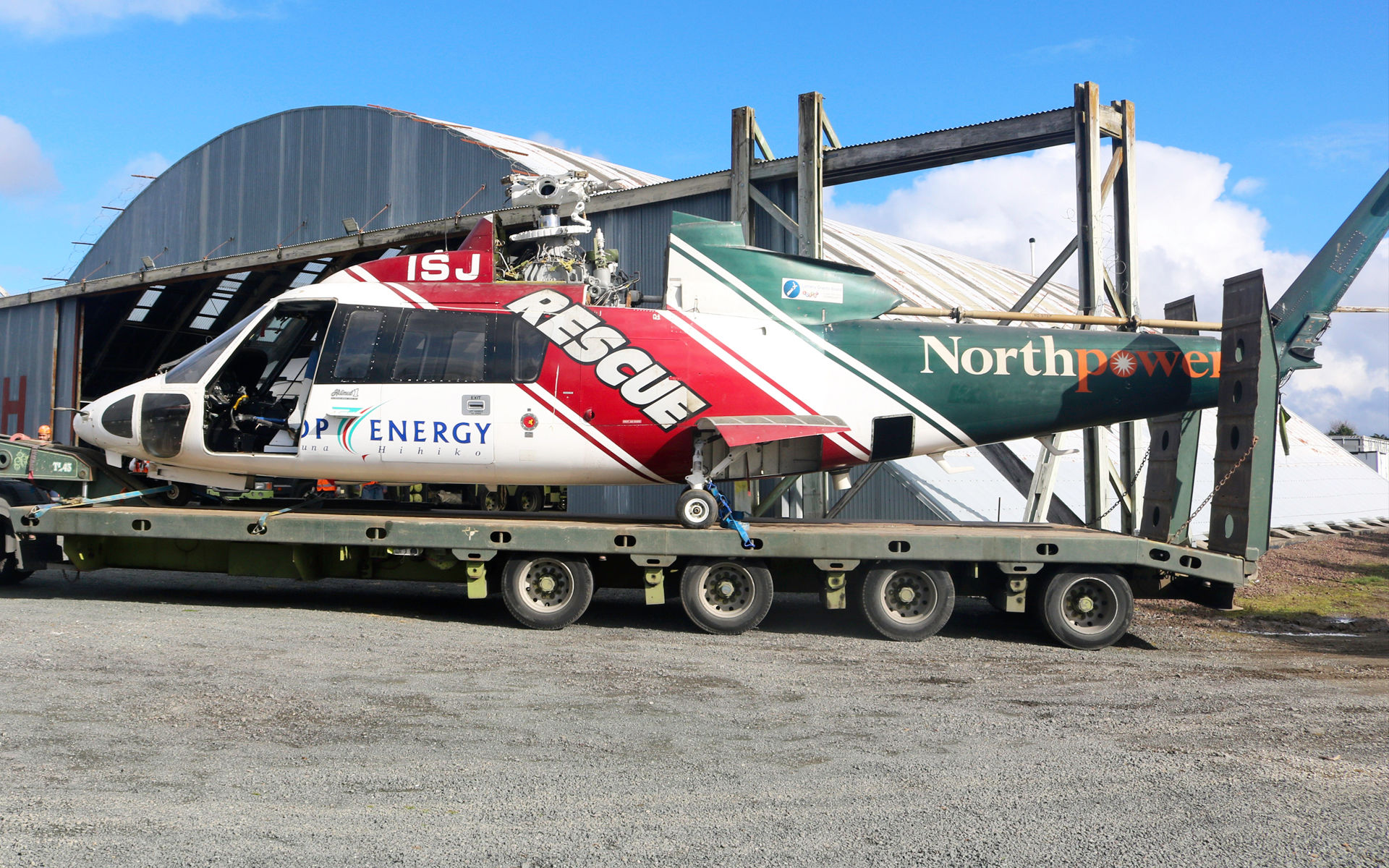
We salute you, Juliet!
A helicopter pioneer
Igor Sikorsky (b. 1889 – d. 1972) was interested in aviation from an early age and followed its developments in Europe, such as those of French aviator and innovator Louis Blériot and his English-Channel crossing from Calais and Dover in an aircraft in 1909. Sikorsky built his first helicopter in 1909, with a second helicopter following in 1910. The latter proved lift but could not take the weight of a pilot.[1] In 1919 he left Russia for America and continued his work in aviation by working on the development of fixed-wing aircraft, forming Sikorsky Aero Engineering Company in 1923. Throughout this period, Sikorsky was still thinking about an aircraft that would be able to generate enough lift to vertically take off and land, seeing the potential for helicopters to benefit society the same way the automobile had.[2] It took a further two decades but in 1939 he built his first successful helicopter, the VS-300. This helicopter stayed aloft for an hour and 32 minutes in 1941, establishing the fundamentals of helicopter flight, which would pave the way for the Sikorsky Aero Engineering Company to manufacture helicopters for a range of civilian and military uses.[3]
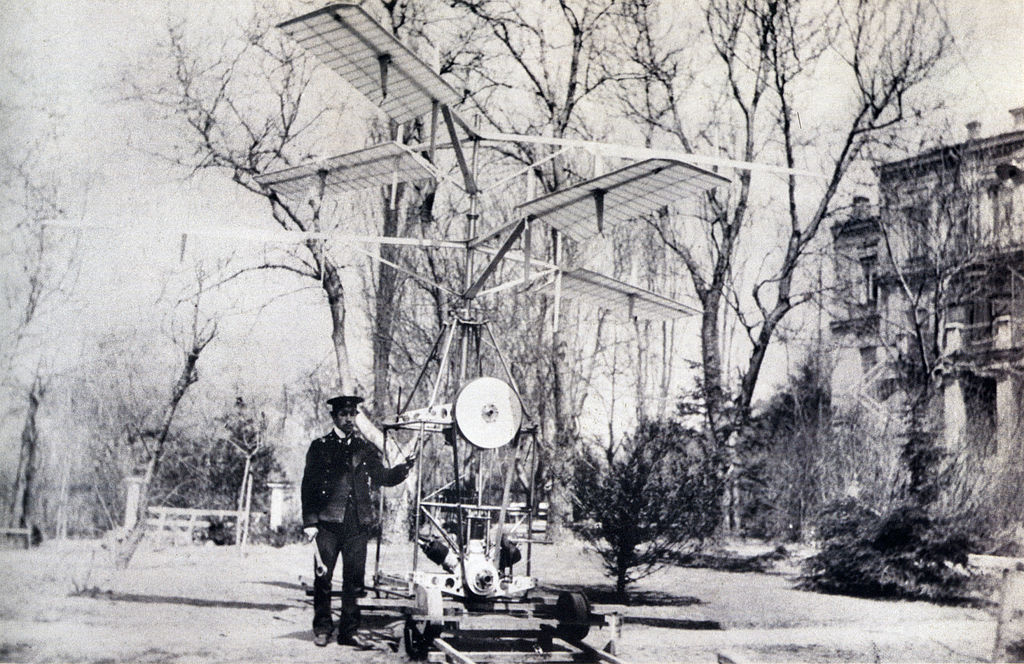
Igor Sikorsky with his second helicopter in 1910, the S-2. Public domain, no known copyright restrictions. Sourced from Wikimedia Commons.
In the 1970s the S-76 type was developed for the commercial market as a medium-lift helicopter, primarily designed for use by the oil drilling sector. The first prototype was flown on 13 March 1977 and production models began delivery from 1978. Prior to this model, Sikorsky’s company had generally focused on the production of helicopters for military application, however, the S-76 was an attempt to expand its market share by developing a medium-lift helicopter for the commercial market. The S76-A type can accommodate two pilots and up to 12 passengers or up to 1,500kg of externally slung freight or equipment, making it particularly suitable for its role in rescue and ambulance contexts.
Touring the globe
Juliet or “Helimed 1”, as it was fondly known in New Zealand, was built with the construction number 760012. This Sikorsky exchanged hands several times before making its way to New Zealand, most notably owned by the King of Jordan, Hussein bin Talal, for the Royal Jordanian Air Force and by Dick Smith of Australia.
It was in October 1991 that businessman and aviator Dick Smith (b. 18 March 1944) took ownership of the Sikorsky in Australia as VH-SHW “World Explorer”.[4] He purchased it for US $1.2 million and replaced both engines to ensure reliability. Dick and his wife, Pip Smith, flew 73,352km in an east-to-west circumnavigation of the globe, a world first in a helicopter history and significant because it was against prevailing winds.
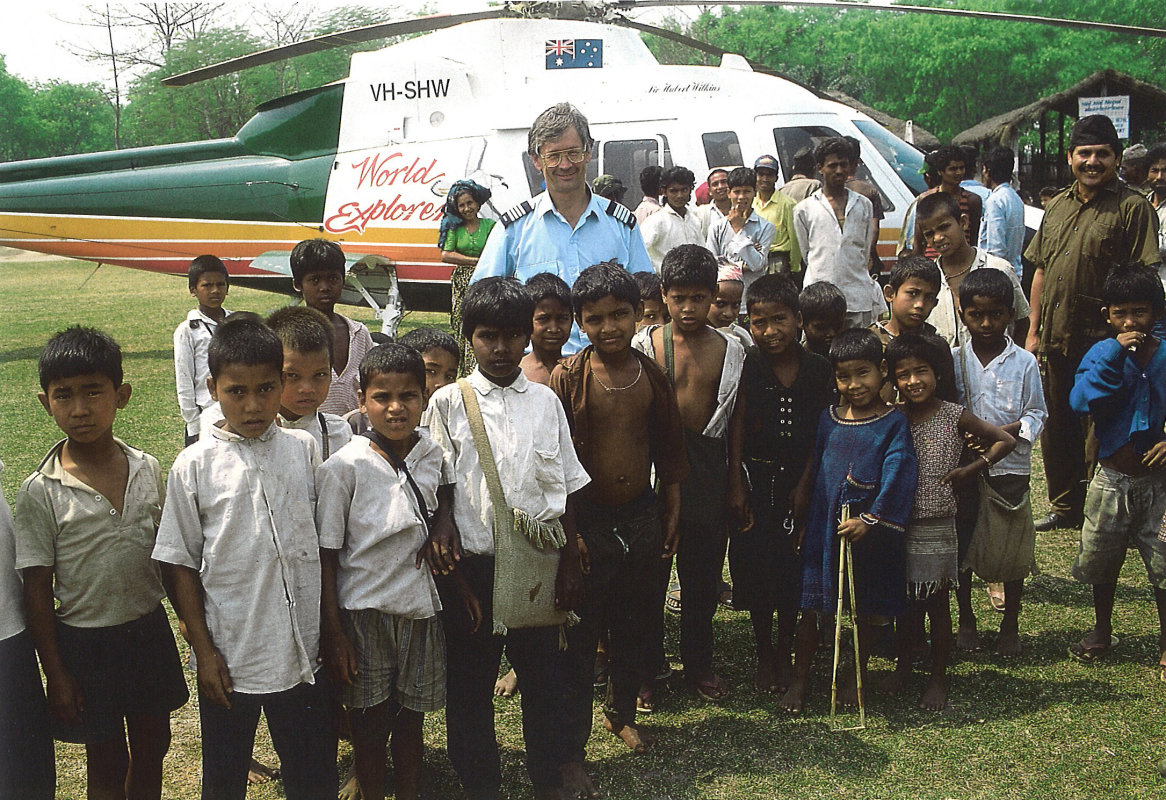
Dick Smith lands in Meghauli in the Chitwan National Park, Nepal. Locals came to see the helicopter. Image courtesy of Dick Smith.
The couple took 10,700 photographs on this trip and travelled to 41 countries. A book produced from this trip, Above the world, showcases the built and natural landscapes they encountered during this trip. To amass such a rich photographic collection, customisations were made to the helicopter, including adding an extra fuel tank to enable longer flights and adding special sliding windows for ease of camera usage. Dick and Pip Smith made a special visit to MOTAT in 2023 to visit the helicopter, which you can read about here.
A life-saving career change
On 21 August 1997 the Sikorsky was ferried to New Zealand via Lord Howe and Norfolk Islands, reaching Whangārei where it was registered as ZK-ISJ. From 3 September 1997 it was operated by the Order of St John - Auckland Regional Trust Board and then Northland Emergency Services Trust (NEST, now operating as Northland Rescue Helicopters Limited NRHL) from 8 October until retirement in December 2019.
Rescue with the aid of aircraft has a long history in New Zealand. During the 1930s, fixed-wing aircraft were used to assist in searching for missing people on land and for lost boats at sea.[5] In the 1960s and 1970s the Royal New Zealand Air Force’s Iroquois helicopters assisted with rescue missions but there was growing need for dedicated helicopter services that could focus on rescue and medical services. The first helicopter rescue service was started during the 1970-1971 summer period for Auckland’s West Coast beaches by Auckland Surf Life Saving Association. They leased a Hillier 12E helicopter for ocean rescues – this was also a world first in having a dedicated ocean rescue service.[6]

Juliet ZK-ISJ in an earlier livery at NEST’s Whangārei base. Courtesy of photographer, Stephen Gyde. Supplied by Derek Quinn
In 1988 NEST’s emergency medical service (EMS) was formed and covered 42% of the North Island’s territory. The Trust formed following a public meeting that discussed providing a rescue helicopter for the upcoming summer months.[7] Prior to this, emergency air services could be provided using small fixed-wing aircraft at Whangārei Airport, a Cessna and De Havilland Dove.[8] This arrangement still required the service of ambulances to move the patient from the airfield to the hospital, which is critical time for someone who is seriously injured. Te Tai Tokerau, like much of Aotearoa, has the complicating factor of rugged and remote terrain, so the ability of a helicopter to land in more challenging landscapes also aids the effectiveness of an EMS.
The first helicopters operated by NEST were a Bell Jet Ranger, a Squirrel AS350 and, finally, a Bölkow Kawasaki BK117 before it purchased the Sikorsky S-76A call sign ZK-ISJ. A second S-76 followed in 2003 (ZK-IAL) and a third in 2011 (ZK-IKM). NEST began with about 100 hours flying time per year and this figure rose to more than 1000 by the time all three Sikorskys were part of the fleet.[9] When the EMS was initiated, it was followed by a fundraising campaign to build helipads at, or close to, Northland’s medical facilities. In Whangārei, initially the helicopters would have to land at Hora Hora School and then transport the patient in an ambulance to the hospital – around a five-minute journey but, again, less practical than being able to land at the hospital.[10]
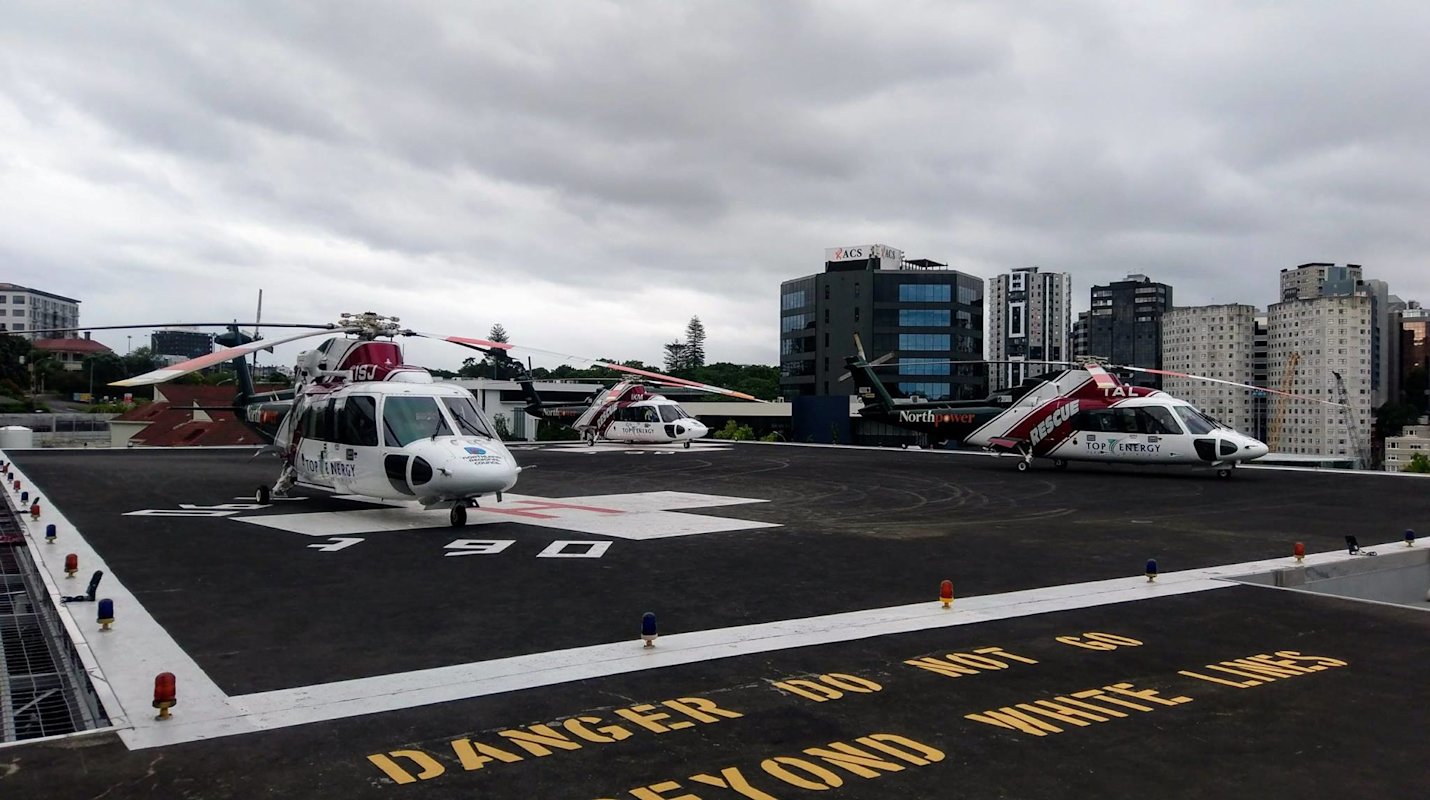
A photograph from 2018 when the three Northland Rescue Helicopters were all on Auckland City Hospital’s roof at the same time – a rare occasion. Lima (IAL) transferred a neonatal patient from Whangārei to Auckland hospital, while Mike (IKM) and Juliet (ISJ) transferred a baby and mum from Kaitaia to Auckland hospital. Image courtesy of Northland Rescue Helicopters. All rights reserved.
10,000 hours in flight
While owned by NEST, Juliet flew 9333 hours and was eventually retired with a total of 10,633.6 hours of flight time. It was the only aircraft in NRHL's fleet for close to three years and was used extensively for Inter-Hospital Transfers (IHTs) and pre-hospital work, which included day and night landings on beaches, farmlands, roads or in the bush, as well as winching to boats up to 270 kilometres out to sea. The helicopter would be crewed according to the type of work being carried out or depending on the type of emergency NEST was responding to. This included hospital staff for IHTs and a mixture of NRHL’s paramedics, including those qualified to operate the winch when it was required in first-response situations.
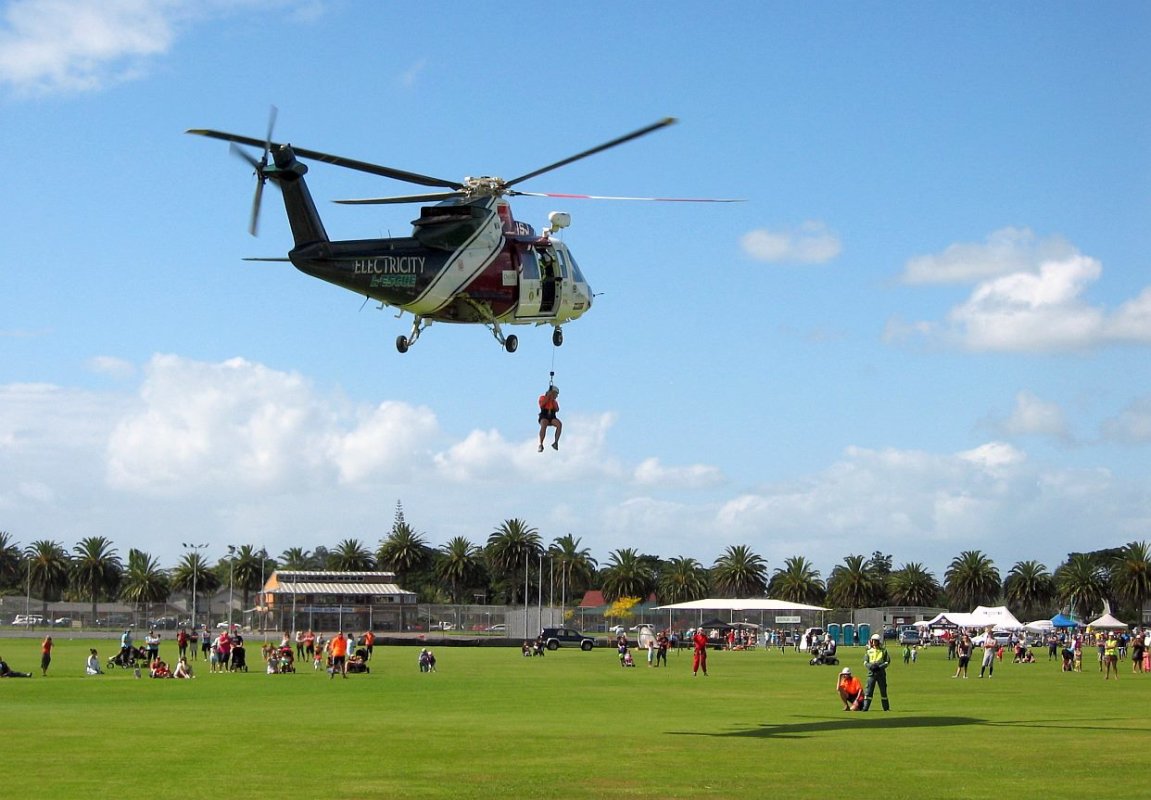
Winch demonstration with the Land SAR team in 2012. Image courtesy of Northland Rescue Helicopters. All rights reserved.
Today, NRHL has a crew of 18 pilots and 15 paramedics supported by a team of 7 engineers. It is a sector than has seen a rise in women joining up as paramedics and aircrew.[11] The service is funded through several revenue streams, including funding from the Ministry of Health, along with support from the Northland Regional Council in the form of a rate on Northland’s ratepayers. It also relies on generous locals and corporate sponsors such as Northpower and Top Energy.

Sue Dinkelacker has been a rescue pilot in Northland since 2019. In 2023 she achieved the outstanding milestone of 10,000 flying hours! Image courtesy of Northland Rescue Helicopters. All rights reserved.
Technology in action
NEST was the first helicopter rescue service in New Zealand to fly using instrument flight rules (IFR) in cloud with the Sikorsky fleet, along with having weather stations installed in strategic locations around Northland – a feat that makes it able to say the fleet is able to fly 99.9% of the time when the service is requested.[12] These technical additions enabled Juliet (ZK-ISJ) to be one of the helicopters that responded during the 2011 Christchurch earthquake, where it was one of the first on the scene due to its ability to fly using IFR.[13]
ZK-ISJ was also fitted with specialised equipment to fly at night. The cockpit was refitted to work with the night-vision goggles worn by the pilots, which made night flying significantly safer for the patients and crew. Prior to this, pilots would rely on lights affixed to the helicopter to see the ground below.
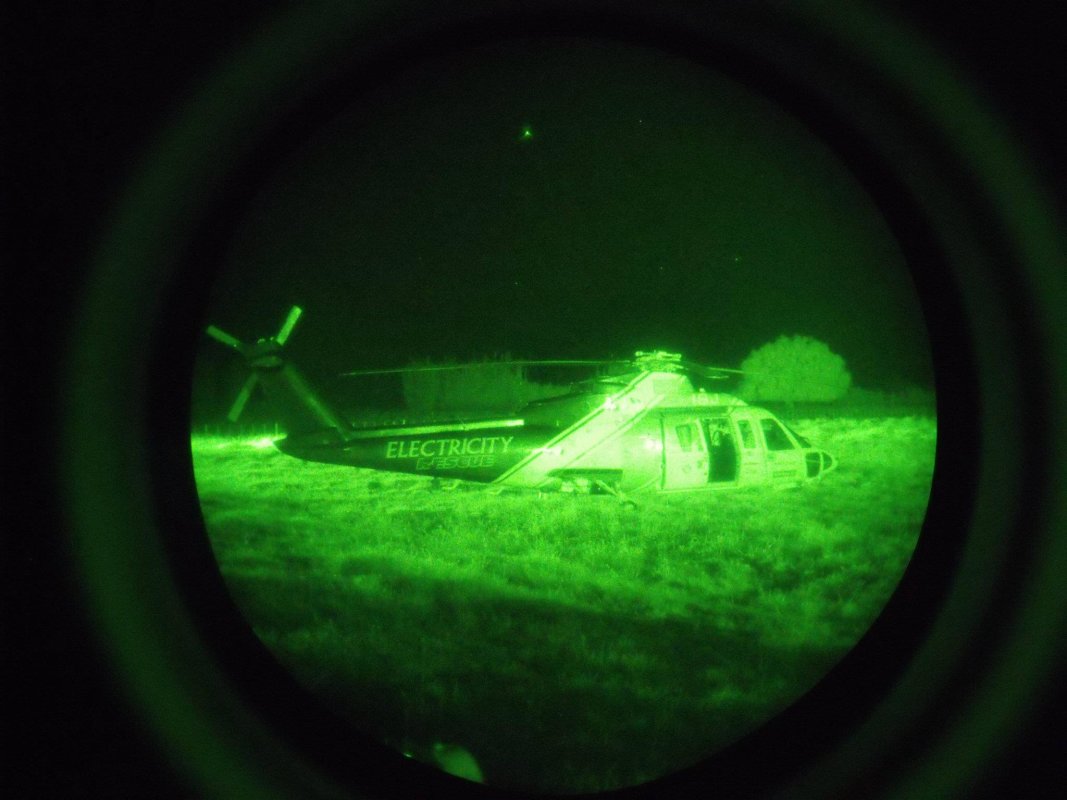
With Night Vision Goggles (NVG) trees, wires, obstacles, ground surface and accident scene become visible. NVG significantly increases the safety of the operation, and the EMS was one of the first rescue organisations to invest in this technology. Image courtesy of Northland Rescue Helicopters. All rights reserved.
When in service, the helicopter was powered by two 650-shaft horsepower Allison 250-C30S turbo-shaft engines, which were able to carry up to 4762kgs (includes weight of helicopter) and if one engine failed it could operate at 700shp for 2.5 minutes.[14]
Juliet’s landing gear is also different to the skids you might see on other helicopters. It has retractable wheeled landing gear termed “tricycle landing gear.” This type of landing gear gives a helicopter more taxiing capabilities on the ground but retains the benefit of vertical take-off and landing not offered by fixed-wing aircraft. While skids offer a cost-efficient mode of operation that requires little maintenance, a helicopter must be under hover power for ground movements when it has skids. Wheeled landing gear can be a safer on powerful medium and heavy lift helicopters because when hovering, a dangerous amount of downwash can be crated when close to the ground, which can be harmful to surrounding objects.
Juliet’s legacy
When Juliet (ZK-ISJ) was in service in 2015, a helicopter cost NEST about $5000 an hour to operate. However, the ability to offer an air service significantly reduced wait times for patients. Retrieval from a furthest point by road ambulance could take anywhere between three to four hours, compared to only 40 minutes by an air ambulance.
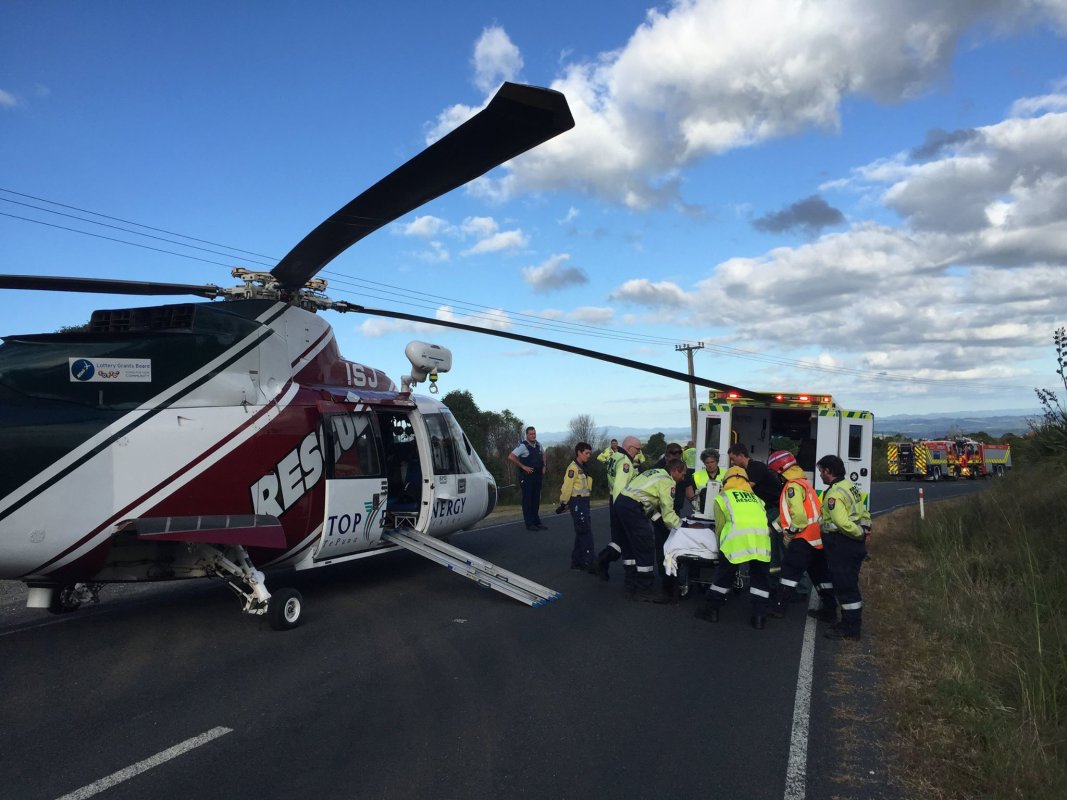
Juliet attends a roadside incident in 2016. Image courtesy of Northland Rescue Helicopters. All rights reserved.
Juliet served the people of Northland for more than 20 years. It was described by NEST as integral to the charity’s decision to build the fleet of Sikorsky helicopters – giving the team the ability to hold more equipment, carry more passengers because of the larger cabin, and fly for longer because of its twin engines.15
In 2023, MOTAT was generously gifted Juliet by NRHL, and the museum started preparing for the logistics for its arrival. One important part was the careful transporting of the helicopter from Whangārei to MOTAT’s Motions Road site. The journey was more than 170 kms and its arrival can be watched here.
In the months following its arrival, a crew of dedicated MOTAT aviation team members have reassembled the helicopter with key parts supplied by NRHL or replicated using 3D printed components where necessary.
MOTAT is honoured to showcase Juliet (ZK-ISJ) to our visitors at our LIVE DAY: First Response in February 2024, and is proud to have this incredible aircraft in our permanent collection for future generations to engage with.
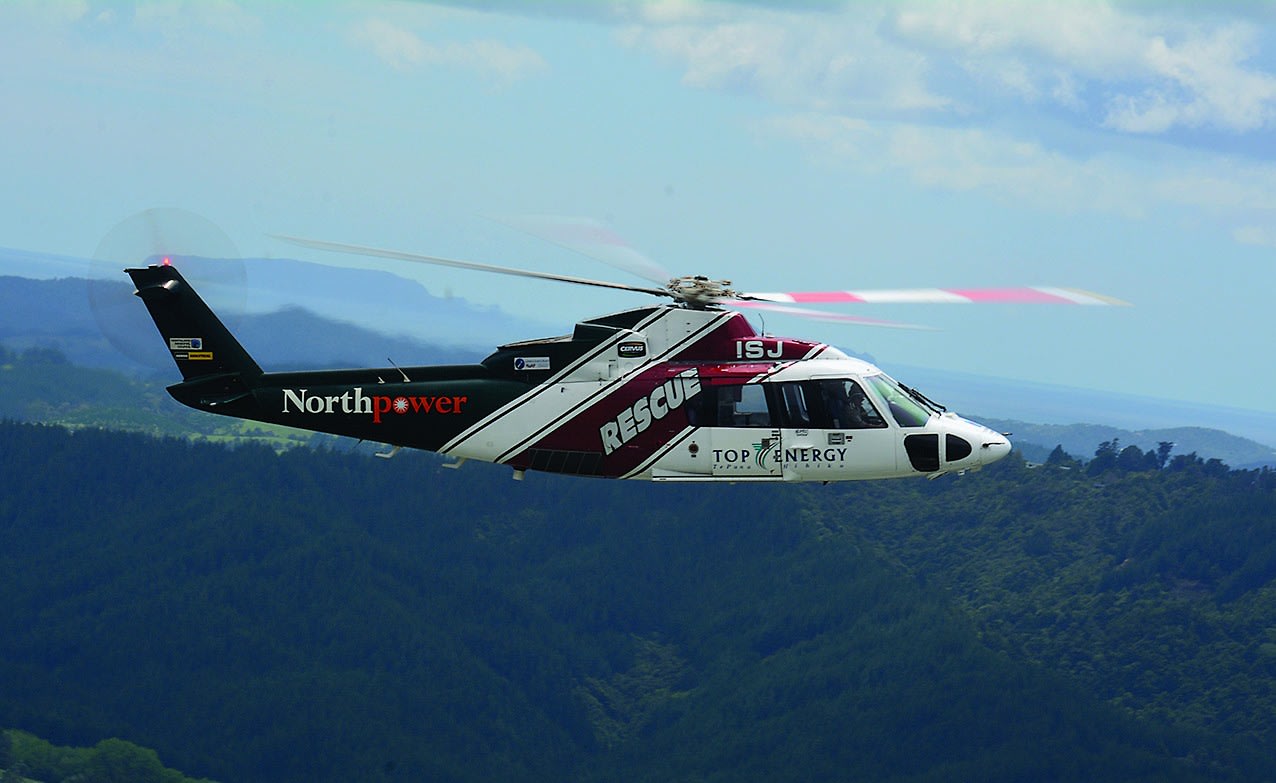
In December 2019, Juliet went into retirement after completing a last flight over Whangārei on 8 December, 2019. Image courtesy of Northland Rescue Helicopters. All rights reserved.
Story by Chelsea Renshaw, Curator – Transport, MOTAT.
Published February 2024.
Footnotes:
[1] Sikorsky Historical Archives. 2023. The Life of Igor Sikorsky. Accessed December 2023: https://sikorskyarchives.com/home/igor-sikorsky/
[2] Lockheed Martin. N.d. Sikorsky, A 100-year legacy of innovation Pioneering Flight Solutions that Bring People Home Everywhere, Every Time. Accessed December 2023: https://www.lockheedmartin.com/en-us/capabilities/sikorsky/sikorsky100.html
[3] Sikorsky Historical Archives. 2023. The Life of Igor Sikorsky. Accessed December 2023: https://sikorskyarchives.com/home/igor-sikorsky/
[4] The Sikorsky was later registered as VH-CFH on the 14th of August 1995 under the Dick Smith Adventures Pty Ltd name.
[5] Nancy Swarbrick and Dan Clearwater. 2023. “Search and rescue”, Te Ara - the Encyclopedia of New Zealand. Accessed December 2023: https://teara.govt.nz/en/search-and-rescue/print
[6] Auckland Westpac Rescue. 2021. About Auckland Westpac Rescue Helicopter. Accessed December 2023: https://www.rescuehelicopter.org.nz/about
[7] Kiwi Flyer. August-September 2012 issue. The Northland Emergency Services Trust A history of efficiency, capability and growth. Accessed December 2023: https://www.kiwiflyer.co.nz/KiwiFlyer-Issue-12-NEST.pdf
[8] Northland Rescue Helicopters. 2015. NEST Northlands Angels of the Skies 2015 Documentary Part 01. Accessed December 2023: https://www.youtube.com/watch?v=oWwK_eDjpFY
[9] Kiwi Flyer. August-September 2012 issue. The Northland Emergency Services Trust A history of efficiency, capability and growth. Accessed December 2023: https://www.kiwiflyer.co.nz/KiwiFlyer-Issue-12-NEST.pdf
[10] Northland Rescue Helicopters. 2015. NEST Northlands Angels of the Skies 2015 Documentary Part 02. Accessed December 2023: https://www.youtube.com/watch?v=JNgXW7hNZs8
[11] 1News. 2023. More women taking to the skies to save lives in rescue choppers. Accessed December 2023: https://www.youtube.com/watch?v=d8KTBBnlQRk
[12] Ibid.
[13] Northland Rescue Helicopters. 2015. NEST Northlands Angels of the Skies 2015 Documentary Part 01. Accessed December 2023: https://www.youtube.com/watch?v=oWwK_eDjpFY
[14] Allison Engine Company was later acquired by Rolls Royce, so these engines are also known as the Rolls Royce M250 series. See: https://en.wikipedia.org/wiki/Allison_Model_250
[15] Comment made by former CEO and Chief Pilot, Peter Turnbull, at presentation ceremony to MOTAT in July 2023 and covered in Kiwi Flyer. August-September 2012 issue. The Northland Emergency Services Trust A history of efficiency, capability and growth. Accessed December 2023: https://www.kiwiflyer.co.nz/KiwiFlyer-Issue-12-NEST.pdf
Sources:
Auckland Westpac Rescue. 2021. About Auckland Westpac Rescue Helicopter. Accessed December 2023: https://www.rescuehelicopter.org.nz/about
David Eyre. 1988. The illustrated encyclopedia of aircraft in Australia and New Zealand, 07-1249. Walsh Memorial Library, The Museum of Transport and Technology (MOTAT).
David Paull. Sikorsky S-76A ZK-ISJ. Accessed November 2022: http://nzcivair.blogspot.com/2012/12/sikorsky-s-76a-zk-isj.html
Emails between NRHL and MOTAT. 2022.
Kiwi Flyer. August-September 2012 issue. The Northland Emergency Services Trust A history of efficiency, capability and growth. Accessed December 2023: https://www.kiwiflyer.co.nz/KiwiFlyer-Issue-12-NEST.pdf
MAAS Curator Margaret Simpson. 2015. Wall map of the world showing Dick Smith's expedition routes 1964-2013. Accessed November 2022: https://collection.maas.museum/object/525383
Michael J. H. Taylor et al. 1978. Helicopters of the world, 02-277. Walsh Memorial Library, The Museum of Transport and Technology (MOTAT).
Mototok. 2021. Wheeled helicopters: their purpose, and how to move them. Accessed November 2022: https://www.mototok.com/blog/wheeled-helicopters-their-purpose
LinkedIn. 2023. Northern Rescue Helicopter. Accessed December 2023: https://www.linkedin.com/company/northern-rescue-helicopter-ltd/?originalSubdomain=nz
Lockheed Martin. N.d. Sikorsky, A 100-year legacy of innovation: Pioneering Flight Solutions that Bring People Home Everywhere, Every Time. Accessed December 2023: https://www.lockheedmartin.com/en-us/capabilities/sikorsky/sikorsky100.html
Nancy Swarbrick and Dan Clearwater. 2023. 'Search and rescue', Te Ara - the Encyclopedia of New Zealand. Accessed December 2023: https://teara.govt.nz/en/search-and-rescue/print
Northland Rescue Helicopters. 2015. NEST Northlands Angels of the Skies 2015 Documentary Part 01. Accessed December 2023: https://www.youtube.com/watch?v=oWwK_eDjpFY
Phillip Treweek. 1998. Sikorsky S-76A. Accessed October 2022: http://www.kiwiaircraftimages.com/s76.html
Sean Willis. 7th December 2015. A Day Onboard the Northland Rescue Helicopter. Accessed December 2023: https://www.youtube.com/watch?v=OajkJXc4HI0
Sikorsky Historical Archives. 2023. The Life of Igor Sikorsky. Accessed December 2023: https://sikorskyarchives.com/home/igor-sikorsky/
1News. 2023. More women taking to the skies to save lives in rescue choppers. Accessed December 2023: https://www.youtube.com/watch?v=d8KTBBnlQRk